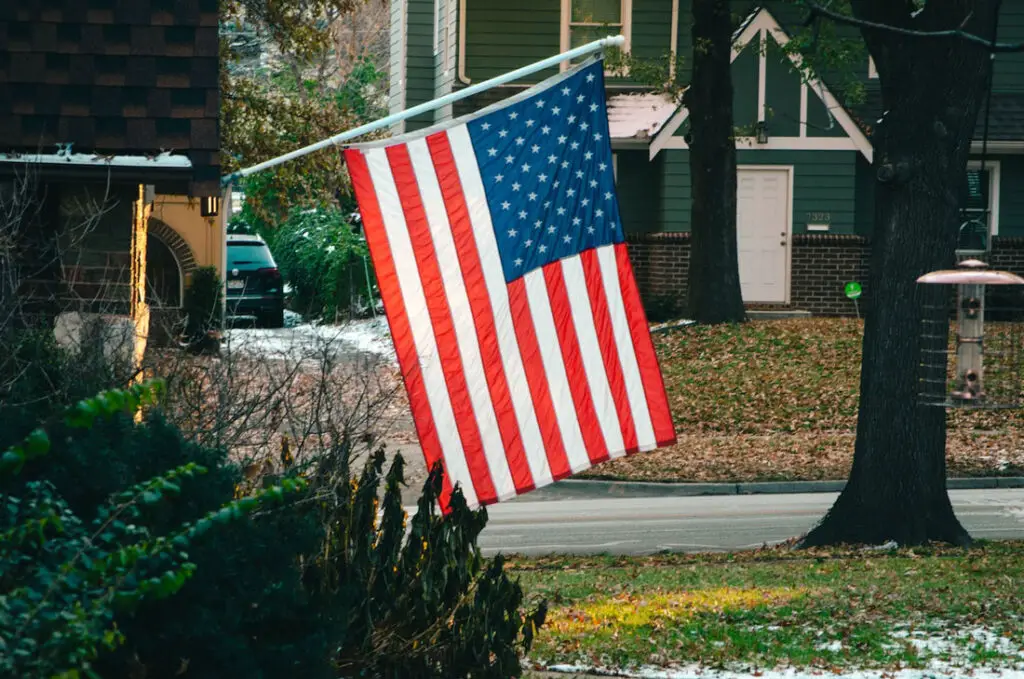It’s a well-worn cliche from the 1950s – “Run it up the flagpole and see if anyone salutes.” Today, you can have your own American flagpole to show your patriotism and give both guests and passersby a U.S. flag to salute, respect, and admire right on your own property.
Flagpoles have long been de rigueur for seaports and yacht clubs, but all homeowners now also enjoy the prestige and pleasures of their own mast. Therefore, if you want to fly Old Glory on your personal property, you absolutely can, with a few caveats and flag etiquette rules.
You definitely have to be aware, flag etiquette is taken seriously here in the United States. Woe betide anyone who violates flag laws—flouting flag rules reportedly cost one high-profile real estate tycoon $100,000 at one of his oceanfront estates.
As you select the best flagpole for your property, consider placement, and prepare to fly your own flag, you may need to brush up on American flag etiquette. Here is a good guide to help you get more familiar with the do’s and don’ts when it comes to flag display, as well as other helpful tips you will need to know.

Types of Flagpoles to Consider
Flagpoles are no longer clunky wooden poles or recycled aluminum sailboat masts. You have a lot of material choices to pick from, each with its own advantages.
Modern flagpoles are mostly electrically non-conductive and absorb sound— which means no more banging of snaps on a metal pole when the flag is flying in a breeze. Many poles are made of resilient and lightweight fiberglass, even though metal flagpoles are still available.
Flagpoles come in varying heights to fit your property. You will find a lot of owning restrictions and governing rules about how tall a flagpole can be, so be sure to know the laws in your neighborhood before settling on a certain height. The most standard height is about 20 feet in residential areas, but you may want a taller pole if you have a lot of greenery and trees or have a larger, multi-story home.
Generally, you will find flagpoles in three distinct styles. One of the most traditional flagpole styles, and the one seen at most yacht clubs, has a crosspiece called a yardarm as well as an angled gaff. A second version has just the yardarm, and the simplest (and least expensive) is a single, standalone flagpole.
If you want to fly only the American flag, all you need is a single pole. But if you want more flags fluttering in the ocean breeze, opt for a flagpole with a yardarm and perhaps a gaff.
- ❤Glory the World, American Flag - Proudly display your American flag. This 4X6 ft Outdoor American flag is very suitable to celebrate "Independence Day", "President's Day", "Labor Day", "Christmas" and other major special holidays, and is displayed every day. America's number one in the world.
- ❤High Quality Embroidered Stars - 50 luxury ebroidered stars and stitches are exquisitely made. Each shiny star is embroidered with fine high-quality white thread. The fine stitching process ensures the texture of the national flag, Shows the craftsmanship of the American flag maker.
- ❤High Quality Brass Grommets - Two golden brass grommets are fastened to the two ends of the American flag and are used to hang solid brass buckles on the flagpole. The golden brass grommet is heavy and rust-proof, very suitable for flying in all weather conditions.
- ❤High Quality Water Resistant - Because of the waterproof coating, The flag is very suitable for hanging indoors or flying outdoors all year round. This 4 by 6 usa flag heavy duty outdoor can be used for a long time, witnessing our American spirit and patriotism.
- ❤ 100% Satisfied Service - This is high quality flag! Your satisfaction is our luck. Please feel free to contact us if you have any questions!We will provide you with a satisfactory solution. (Gives you a 180-day full warranty -- No matter what goes wrong.)

7 Rules For Flying The American Flag At Home
Basic Rules of Etiquette with the American Flag
1. Position the flag properly
The union (field of stars) on the flag should always be placed to the left in the upper corner. Further, the flag should always be hoisted to the top of the pole.
There are, however, certain instances when it is acceptable to display the flag in other ways. For example, the flag can be flown at “half staff” during a time of significant mourning. For example, if a prominent government figure passes away, the flag can be flown at half-staff. You can also place the flag at half-staff on Memorial Day until noon in lieu of remembrance.
The American flag should never be flown upside down; this is only done when the country is in significant distress.
2. The flag should be allowed to fly freely
When you hang a flag on a pole, it should only be fastened along the left side so the rest of the flag falls freely and flies freely when the wind blows. Old Glory should never be tied up, fastened, or otherwise held taught so that it cannot move gracefully with the breeze.
Remember: Just like freedom, the flag should be unrestricted when on display.
3. Take down the flag during inclement weather
Flags available today are often made with some pretty resilient materials. Therefore, most can withstand a little rain, snow, or sun exposure. Nevertheless, if you are anticipating severe weather or wind that could cause damage to the flag, the general rule is to take down the flag and store it properly.
Remember: The American flag is meant to be respected and protected, so removal before a storm is perceived as a sign of just that.
4. Illuminate the flag if displaying after dark
If you have an all-weather flag, you can leave it displayed at all times, dark or daylight. However, if flying Old Glory after dark, make sure it is properly illuminated with a floodlight or spotlight. It is considered in bad taste to have a flag out after dark that is not properly illuminated. If you are unable to illuminate the flag properly, it should be taken down every day at sunset.
Remember: The American flag should be visible at all times when on display.
5. Nothing goes above the American flag
Generally speaking, if you plan to display a flag in your yard with other flags, the American flag takes the position of honor, always. This means the U.S. flag should have the highest position in a group of flags, even if the flags are on the same pole.
If you are displaying a state flag, a flag from another country, and the American flag, for example, on multiple poles in your yard, Old Glory should be positioned in a way that it is taller than the rest.
The only situation in which the top-placement rule does not apply is if you have a gaff. If you have a gaff adjacent to the main pole, attach the American flag to it, and then use the top of the flagpole (masthead) for a personal flag of your own design called a “private signal.” This was traditionally used for naval signal flags, and some places use the private signal spot for something like a club pennant flag.
Remember: Unless you have a gaff, nothing goes above the American flag.
6. The flag should not touch anything
When the flag is on display on a flagpole, it should not touch anything. For example, the pole should be tall enough that the flag cannot touch the ground and far enough from structures, trees, and other implements that it won’t brush against anything as it flies. Likewise, the flag should be held from the ground during raising and lowering.

Yardarm Flagpole Etiquette
What is a yardarm? Yardarms, also called crosstrees, are on gaff-rigged flagpoles. Gaff-rigged flagpoles resemble what is used at sea by naval ships, and the yardarms allow for added halyards to attach other types of flags or signals.
Yardarms are used by many yacht clubs to fly the flags of officers at the club, but you can also use this for your own purposes. You can use the yardarm’s halyards for fun signals: A martini flag means it’s sundowner cocktail hour, and a barbecue flag means it’s time to eat. A battle-ax flag could mean the mother-in-law is in residence—although flying that is at your own peril.
Remember: The rule is that the U.S. flag should be above any flag on the yardarm.
Rules for Flag Disposal
When a flag reaches a point where its condition is no longer fitting for representing the nation, the flag should be retired. Even flag retirement and disposal come along with a few caveats. The rules state that the flag should be destroyed in a “ceremonious and dignified” way, and burning the flag is the preference.
If you are uncomfortable with flag disposal yourself, reach out to your local American Legion Post. Most will handle retiring worn and ragged flags ceremoniously at certain times of the year. Likewise, some groups, such as the Boy Scouts of America, handle flag disposal as well.
Contrary to popular belief, a flag does not have to be destroyed if it touches the ground. The primary reason to avoid touching the ground is out of respect and to prevent the flag from getting dirty. If the flag still appears suitable and clean, it can be used. Washing or dry-cleaning the flag is even an acceptable practice if it does get soiled.
Rules for Flag Handling and Storage
When raising and lowering the flag, or taking it down for storage, it should be handled with care. Don’t allow the flag to touch the ground so it does not get soiled when you are removing it from the flagpole.
When the flag is taken down for storage, it should be folded properly and kept in a safe place. The proper way to fold a flag involves folding it lengthwise aligned with the stripes, and then folding in a triangle from one end until the full flag is in a triangle shape. You will have a small flap remaining that can be tucked into the fold for securing the fold.
When you are storing the flag, it should never be stored on the ground. Instead, the flag should be in a storage box, drawer, or safe place on a shelf. To protect the flag from sunlight, be sure to avoid storage in a window.
How To Install A Flagpole
Installation of a flagpole is straightforward, although you may need a crane for the final lift if you have a substantially tall pole. In general, you will:
- Dig a hole
- Embed a sleeve in the hole
- Stabilize the sleeve in concrete
- Slide the base of the flagpole into the sleeve once the concrete has dried
Longer flagpoles may require a crane for erecting, but most standard poles can be erected by hand.
Where to Put a Flagpole in Your Yard
There really are no written rules about where you can place a flagpole on your property unless you have a governing HOA that dictates placement or other zoning restrictions to consider. The most important thing is to put the pole in an area where the flag can fly freely and won’t be at risk of touching anything as it does. ‘When picking the best spot, consider:
- Do you want the flag visible to you from inside the house?
- Do you want the flag to be visible to onlookers?
- Will the area get a lot of natural light so the flag is visible?
- Will the area get enough wind so the fag can fly?
If possible, pick an area where the flag will get wind from multiple directions so it will wave in the wind regularly. Most people pick an area in a central part of their yard where the flag is at least partially open to the wind, gets ample natural light, and acts as a focal point of the property.
How to Dig a Hole for Your Flagpole
As far as digging the hole, the general rule is to dig a hole that is about 4 or 6 times as wide as the base diameter of the flagpole you plan to install. Your new flagpole should come with a ground sleeve, so the hole should be at least the length of that sleeve with a little added depth for drainage gravel.
Make sure whatever area you choose for your new flagpole is a safe spot for digging. You may have underground utility lines to consider, and you don’t want to disrupt those lines while digging for flagpole placement. To find out more about underground utilities, you can simply call 8-1-1 to have a technician come out and mark lines for you.

When to Fly the American Flag at Half-Mast
As a symbol of our nation, the American flag is flown high and proud across homes, businesses, and public institutions. But, there are times when it’s appropriate to lower the flag to half-mast (or half-staff, as it’s also known) as a gesture of mourning, respect, or remembrance.
- Memorial Day
Perhaps the most well-known occasion for flying the flag at half-mast is Memorial Day. This federal holiday is observed on the last Monday of May each year and is dedicated to remembering and honoring the men and women who have died while serving in the United States Armed Forces. On Memorial Day, the flag should be flown at half-mast from sunrise until noon, then raised briskly to the top of the staff until sunset to symbolize the nation’s resolve not to let their sacrifices be in vain.
- National Pearl Harbor Remembrance Day
On December 7th, we observe National Pearl Harbor Remembrance Day to commemorate the attack on Pearl Harbor in 1941, which led to the United States’ entry into World War II. On this day, the President typically issues a proclamation, directing the flag to be flown at half-mast on all federal buildings, grounds, and naval vessels.
- Death of a President or Former President
Upon the death of a sitting or former President of the United States, the flag is flown at half-mast for a period of 30 days from the day of their passing. For a Vice President, Chief Justice, or Speaker of the House, the flag is flown at half-mast for ten days from the day of death.
- Death of a Member of Congress
In the event of the death of a current or former member of Congress, the flag is typically flown at half-mast on the day of death and the following day, as a mark of respect and mourning.
- Presidential Proclamations
The President of the United States may issue a proclamation directing the flag to be flown at half-mast in the wake of national tragedies, such as mass shootings, natural disasters, or the death of a significant public figure. The duration of the half-mast period may vary, as specified by the President in the proclamation.
- State and Local Proclamations
Governors of individual states and territories, as well as the mayor of the District of Columbia, may also order the flag to be flown at half-mast within their respective jurisdictions to honor local heroes, observe state-specific remembrance days, or in response to local tragedies.
5 Notable Cases of Flag-Related Crimes in the United States
The American flag is a powerful symbol of our country’s values and history, and for many people, it is a deeply meaningful symbol of freedom and patriotism. However, not everyone sees the flag in the same way, and there have been cases throughout history of people who have been charged with crimes related to their treatment of the flag. In this article, we will explore five notable cases of flag-related crimes in the United States.
Richard Dillon: The Michigan Man Charged with Burning the American Flag in Protest
In 2016, Richard Dillon, a resident of Michigan, was charged with felony ethnic intimidation after he burned an American flag on his property in protest of the presidential election. The charge was later dropped. The case highlights the tension between free speech and hate speech, and the fine line that separates them.
Bryton Mellott: The Illinois Man Arrested for Burning the American Flag and Posting the Photo on Facebook
In 2016, Bryton Mellott, an Illinois resident, was arrested and charged with disorderly conduct after posting a photo on Facebook of himself burning an American flag. The charge was dropped after the state attorney’s office determined that the act was protected by the First Amendment. This case illustrates the importance of understanding the limits of the law when it comes to expressing controversial views.
Eric Sheppard: The Georgia Student Charged with Inciting a Riot After Walking on the American Flag
In 2015, Eric Sheppard, a student at Valdosta State University in Georgia, was charged with inciting a riot after he walked on an American flag as part of a protest against racism. He later turned himself in to authorities and the charges were dropped. This case raises questions about the appropriate balance between free expression and public safety.
Joey Johnson: The Revolutionary Communist Youth Brigade Member Arrested for Flag Desecration at the Republican National Convention
In 1984, Joey Johnson, a member of the Revolutionary Communist Youth Brigade, was arrested and charged with flag desecration after burning an American flag at the Republican National Convention in Dallas, Texas. The case eventually made its way to the Supreme Court, which ruled that flag burning was protected under the First Amendment. This landmark case established an important precedent for the protection of political speech.
Duy Tran: The Texas Resident Threatened with Eviction for Displaying the American Flag in His Window
In 2014, Duy Tran, a resident of Texas, was threatened with eviction from his apartment complex after he displayed an American flag in his window. The complex had a rule against displaying flags, but Tran argued that the rule was unconstitutional. The complex eventually backed down and allowed him to keep the flag. This case highlights the ongoing debates about the rights of property owners and the rights of individuals to express themselves in public spaces.
Wrap Up
In conclusion, understanding and respecting American flag etiquette is an important way to show patriotism and respect for our country and its history. The American flag has a rich and storied history, serving as a symbol of our nation’s values and ideals.
From the original 13 colonies to the present day, the flag has been a source of inspiration and pride for Americans everywhere. By following flag etiquette guidelines and treating the flag with the honor and respect it deserves, we can continue to honor its legacy and the sacrifices of those who fought for the freedoms it represents.






